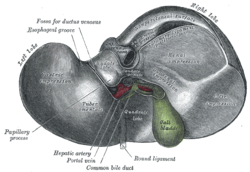Round ligament of liver
| Round ligament of liver | |
|---|---|
 Inferior surface of the liver. (Round ligament labeled at bottom.) | |
 1: Right lobe of liver 2: Left lobe of liver 3: Quadrate lobe of liver 4: Round ligament of liver 5: Falciform ligament 6: Caudate lobe of liver 7: Inferior vena cava 8: Common bile duct 9: Hepatic artery 10: Portal vein 11: Cystic duct 12: Hepatic duct 13: Gallbladder | |
| Details | |
| Precursor | left umbilical vein |
| Identifiers | |
| Latin | ligamentum teres hepatis |
| MeSH | D000069592 |
| TA98 | A05.8.01.015 |
| TA2 | 5104 |
| FMA | 14079 |
| Anatomical terminology | |
In anatomy, the round ligament of (the) liver (also commonly known by its Latin name, ligamentum teres - or more specifically ligamentum teres hepatis) is a degenerative string of tissue that exists in the free edge of the falciform ligament of the liver. Anatomically, the round ligament divides the left part of the liver into medial and lateral sections.
The round ligament represents the remnant of the fetal umbilical vein. The round ligament therefore only exists in mammals. Prenatally and for a month or two after birth, the umbilical vein is patent, subsequently degenerating to fibrous tissue, the round ligament.
In adult-hood, small paraumbilical veins remain in the substance of the ligament. These act as an important portacaval anastomosis in severe portal hypertension, resulting in a caput medusae presentation.
The umbilical vein/round ligament inserts around the umbilicus and is an important landmark of the inner surface of the anterior abdominal wall.
Additional Images
-
Round ligament of liver.Superior surface of liver.
External links
- . GPnotebook https://www.gpnotebook.co.uk/simplepage.cfm?ID=617611323.
{{cite web}}: Missing or empty|title=(help) - Anatomy photo:38:12-0106 at the SUNY Downstate Medical Center - "Stomach, Spleen and Liver: The Visceral Surface of the Liver"
- Anatomy image:7819 at the SUNY Downstate Medical Center
- Overview at ucc.edu
- Illustration of Liver Anatomy including ligaments and structures

